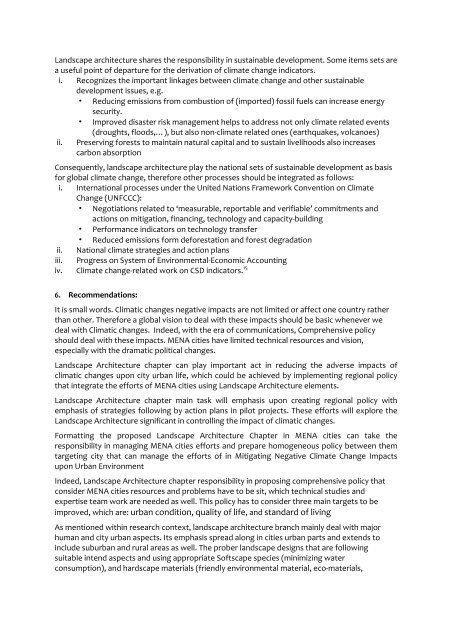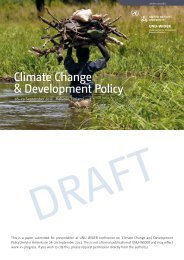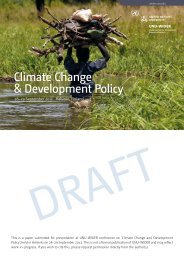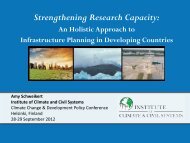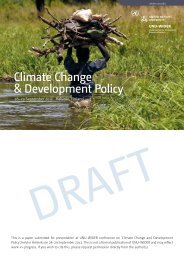Landscape architecture role in mitigating negative ... - UNU-WIDER
Landscape architecture role in mitigating negative ... - UNU-WIDER
Landscape architecture role in mitigating negative ... - UNU-WIDER
You also want an ePaper? Increase the reach of your titles
YUMPU automatically turns print PDFs into web optimized ePapers that Google loves.
<strong>Landscape</strong> <strong>architecture</strong> shares the responsibility <strong>in</strong> susta<strong>in</strong>able development. Some items sets are<br />
a useful po<strong>in</strong>t of departure for the derivation of climate change <strong>in</strong>dicators.<br />
i. Recognizes the important l<strong>in</strong>kages between climate change and other susta<strong>in</strong>able<br />
development issues, e.g.<br />
• Reduc<strong>in</strong>g emissions from combustion of (imported) fossil fuels can <strong>in</strong>crease energy<br />
security.<br />
• Improved disaster risk management helps to address not only climate related events<br />
(droughts, floods,…), but also non‐climate related ones (earthquakes, volcanoes)<br />
ii. Preserv<strong>in</strong>g forests to ma<strong>in</strong>ta<strong>in</strong> natural capital and to susta<strong>in</strong> livelihoods also <strong>in</strong>creases<br />
carbon absorption<br />
Consequently, landscape <strong>architecture</strong> play the national sets of susta<strong>in</strong>able development as basis<br />
for global climate change, therefore other processes should be <strong>in</strong>tegrated as follows:<br />
i. International processes under the United Nations Framework Convention on Climate<br />
Change (UNFCCC):<br />
• Negotiations related to ‘measurable, reportable and verifiable’ commitments and<br />
actions on mitigation, f<strong>in</strong>anc<strong>in</strong>g, technology and capacity‐build<strong>in</strong>g<br />
• Performance <strong>in</strong>dicators on technology transfer<br />
• Reduced emissions form deforestation and forest degradation<br />
ii. National climate strategies and action plans<br />
iii. Progress on System of Environmental‐Economic Account<strong>in</strong>g<br />
iv. Climate change‐related work on CSD <strong>in</strong>dicators. 15<br />
6. Recommendations:<br />
It is small words. Climatic changes <strong>negative</strong> impacts are not limited or affect one country rather<br />
than other. Therefore a global vision to deal with these impacts should be basic whenever we<br />
deal with Climatic changes. Indeed, with the era of communications, Comprehensive policy<br />
should deal with these impacts. MENA cities have limited technical resources and vision,<br />
especially with the dramatic political changes.<br />
<strong>Landscape</strong> Architecture chapter can play important act <strong>in</strong> reduc<strong>in</strong>g the adverse impacts of<br />
climatic changes upon city urban life, which could be achieved by implement<strong>in</strong>g regional policy<br />
that <strong>in</strong>tegrate the efforts of MENA cities us<strong>in</strong>g <strong>Landscape</strong> Architecture elements.<br />
<strong>Landscape</strong> Architecture chapter ma<strong>in</strong> task will emphasis upon creat<strong>in</strong>g regional policy with<br />
emphasis of strategies follow<strong>in</strong>g by action plans <strong>in</strong> pilot projects. These efforts will explore the<br />
<strong>Landscape</strong> Architecture significant <strong>in</strong> controll<strong>in</strong>g the impact of climatic changes.<br />
Formatt<strong>in</strong>g the proposed <strong>Landscape</strong> Architecture Chapter <strong>in</strong> MENA cities can take the<br />
responsibility <strong>in</strong> manag<strong>in</strong>g MENA cities efforts and prepare homogeneous policy between them<br />
target<strong>in</strong>g city that can manage the efforts of <strong>in</strong> Mitigat<strong>in</strong>g Negative Climate Change Impacts<br />
upon Urban Environment<br />
Indeed, <strong>Landscape</strong> Architecture chapter responsibility <strong>in</strong> propos<strong>in</strong>g comprehensive policy that<br />
consider MENA cities resources and problems have to be sit, which technical studies and<br />
expertise team work are needed as well. This policy has to consider three ma<strong>in</strong> targets to be<br />
improved, which are: urban condition, quality of life, and standard of liv<strong>in</strong>g<br />
As mentioned with<strong>in</strong> research context, landscape <strong>architecture</strong> branch ma<strong>in</strong>ly deal with major<br />
human and city urban aspects. Its emphasis spread along <strong>in</strong> cities urban parts and extends to<br />
<strong>in</strong>clude suburban and rural areas as well. The prober landscape designs that are follow<strong>in</strong>g<br />
suitable <strong>in</strong>tend aspects and us<strong>in</strong>g appropriate Softscape species (m<strong>in</strong>imiz<strong>in</strong>g water<br />
consumption), and hardscape materials (friendly environmental material, eco‐materials,


